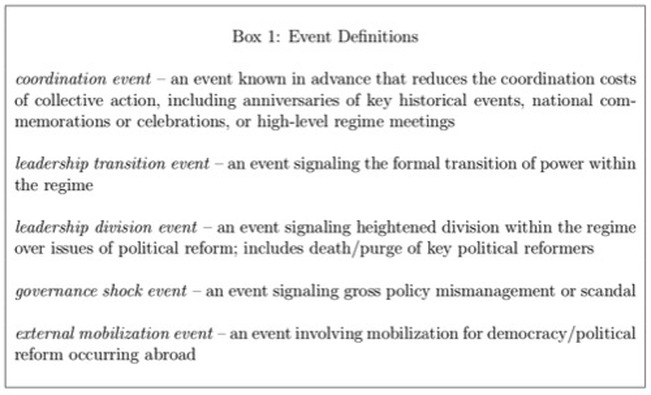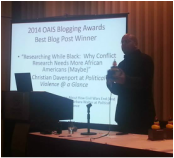One example that engaged both conceptualization and framing was Earl's (2003) typology of repression and her work on repertoires “Culturally Constrained Contention: Mapping the Meaning of the Repertoire of Contention” with Misty Ring-Ramirez and Heidi Reynolds-Stenson. This piece provides opportunities for Truex to connect his typology (below) to existing conceptual and theoretical work, as well as engage the “substitution” ideas that more and more human rights researchers are considering. His focus on “pre-emptive” v “reactive” repression permits these linkages, also echoes recent work by Nordas and Davenport (2013) and Sullivan (2015).
Further, there was considerable discussion about the distinctions Truex makes between detentions of democracy activists (which he studies) and detentions of others who are perceived as a political threat (which he does not study). These include members of the Uyghur minority, members of Falun Gong, etc., and people protesting economic malfeasance or other forms of corruption or mismanagement.
Jennifer Earl offered a great distinction between what might be described as “writing for referees” (in order to get work published, a point of focus for junior researchers) and “writing for readers” (framing one's work so that it has as large an impact as possible). Truex was concerned with trying to engage too many literatures, and thereby “doing none of them justice.” Earl observed that one could look at that as an opportunity for impact rather than an obstacle to publication. She suggested focusing upon the literature that is necessary for the argument (i.e., trim “linkages” that are not necessary), but pursue as many as are available. Doing so well broadens the potential readership and impact. Earl provided another gem identifying scholarship as a compass that facilitated passage through a sea of literature.
Other theoretical issues included some discussion about focusing more on Schelling’s contribution over that of Kuran. An interesting point raised by several individuals concerned focal points and anniversaries. While on the one hand researchers can understand why political challengers would wish to mobilize around such events – people are aware of them and they might be sensitized to situations that remind them of the earlier activity (e.g., Tiananmen Square), there is also an argument that governments are aware of this as well and might try to avoid such focal points. For example, they might repress way in advance of such an event, preventing the inevitable build up. They might just repress the day after the event realizing that most would be unprepared for such a thing. This idea of political calendars was especially provocative getting people to think about all different types of rhythms that exist: anniversaries of killings, changes, purges, assassinations, speeches, etc. This brought to mind the work of William Sewell but also Karen Rasler among others. Additionally, there was an imbalance of sorts regarding the use of the research concerning “political opportunity structure” one pillar of the holy trinity within social movement scholarship. The work kind of relies upon the concept regarding structural characteristics having an impact but it simultaneously challenges the concept by trying to highlight more dynamic changes in concept.
The group (led by Molly Roberts and Haifung Huang) also considered the placement of the work specifically within the growing area of “Chinese Contention” but also within the broader field of contentious politics/contentious politics. The former has emerged over the last decade or so as scholars begin to chip away at understanding what takes place within China concerning government-challenger interactions within numerous high-profile publications. The latter has struggle to readily fit more country-specific insights into a broader focus on global and regional patterns.
Turning to empirics, observations ranged from clarifying the reliability of the data source, statistical models (e.g., a split likelihood function that models “regular day” v “expected protest day”), and the extent to which the data source captures events that about which the public is aware. This latter point drew interest from several of us. Concerns about the extent to which these detentions might spur protest, rather then deter it (as Truex assumes the authority's expect) were raised, and Truex recognizes the obvious point that the 200+ detentions in his dataset are a non-random sample of the census of such detentions. We encouraged him to make an effort to provide more detail about these issues, and to explore modeling the data generation process, not only as a function of state decision making (and dissident decision making), but also how the data he observes get recorded from the underlying population.
To conclude, CCVW generated another engaging interaction over intriguing research that has the potential to not only teach us about the use of detentions in response to expected mobilization given focal points in the political calendar, but raises a number of promising future avenues for research, both by Truex and those who read his work. Clearly Truex enjoyed the interaction, referred to the session as “the coolest academic experience he has had.” Now, that is not something you don't hear everyday.
@engagedscholar & @WilHMoo



 RSS Feed
RSS Feed
